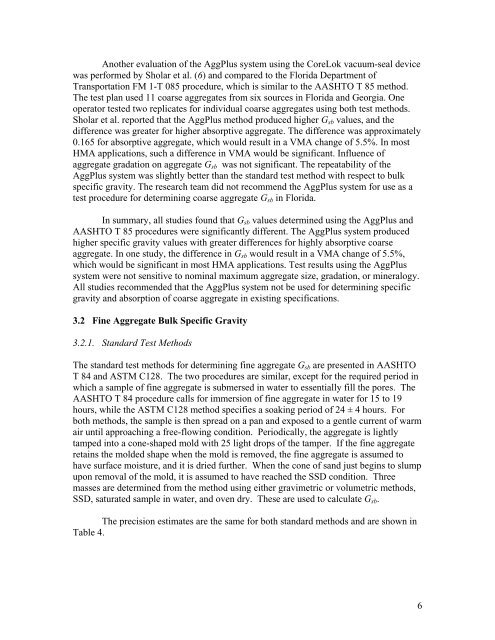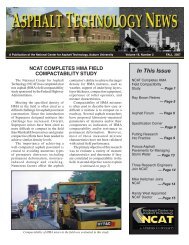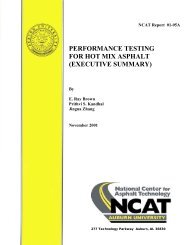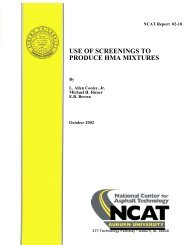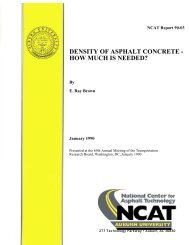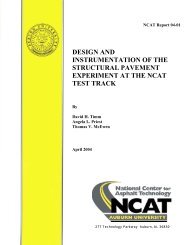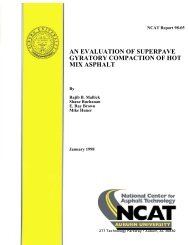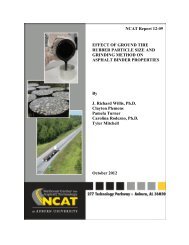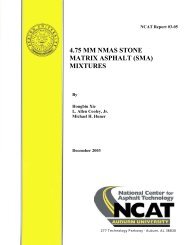A Review of Aggregate and Asphalt Mixture Specific Gravity ...
A Review of Aggregate and Asphalt Mixture Specific Gravity ...
A Review of Aggregate and Asphalt Mixture Specific Gravity ...
You also want an ePaper? Increase the reach of your titles
YUMPU automatically turns print PDFs into web optimized ePapers that Google loves.
Another evaluation <strong>of</strong> the AggPlus system using the CoreLok vacuum-seal devicewas performed by Sholar et al. (6) <strong>and</strong> compared to the Florida Department <strong>of</strong>Transportation FM 1-T 085 procedure, which is similar to the AASHTO T 85 method.The test plan used 11 coarse aggregates from six sources in Florida <strong>and</strong> Georgia. Oneoperator tested two replicates for individual coarse aggregates using both test methods.Sholar et al. reported that the AggPlus method produced higher G sb values, <strong>and</strong> thedifference was greater for higher absorptive aggregate. The difference was approximately0.165 for absorptive aggregate, which would result in a VMA change <strong>of</strong> 5.5%. In mostHMA applications, such a difference in VMA would be significant. Influence <strong>of</strong>aggregate gradation on aggregate G sb was not significant. The repeatability <strong>of</strong> theAggPlus system was slightly better than the st<strong>and</strong>ard test method with respect to bulkspecific gravity. The research team did not recommend the AggPlus system for use as atest procedure for determining coarse aggregate G sb in Florida.In summary, all studies found that G sb values determined using the AggPlus <strong>and</strong>AASHTO T 85 procedures were significantly different. The AggPlus system producedhigher specific gravity values with greater differences for highly absorptive coarseaggregate. In one study, the difference in G sb would result in a VMA change <strong>of</strong> 5.5%,which would be significant in most HMA applications. Test results using the AggPlussystem were not sensitive to nominal maximum aggregate size, gradation, or mineralogy.All studies recommended that the AggPlus system not be used for determining specificgravity <strong>and</strong> absorption <strong>of</strong> coarse aggregate in existing specifications.3.2 Fine <strong>Aggregate</strong> Bulk <strong>Specific</strong> <strong>Gravity</strong>3.2.1. St<strong>and</strong>ard Test MethodsThe st<strong>and</strong>ard test methods for determining fine aggregate G sb are presented in AASHTOT 84 <strong>and</strong> ASTM C128. The two procedures are similar, except for the required period inwhich a sample <strong>of</strong> fine aggregate is submersed in water to essentially fill the pores. TheAASHTO T 84 procedure calls for immersion <strong>of</strong> fine aggregate in water for 15 to 19hours, while the ASTM C128 method specifies a soaking period <strong>of</strong> 24 ± 4 hours. Forboth methods, the sample is then spread on a pan <strong>and</strong> exposed to a gentle current <strong>of</strong> warmair until approaching a free-flowing condition. Periodically, the aggregate is lightlytamped into a cone-shaped mold with 25 light drops <strong>of</strong> the tamper. If the fine aggregateretains the molded shape when the mold is removed, the fine aggregate is assumed tohave surface moisture, <strong>and</strong> it is dried further. When the cone <strong>of</strong> s<strong>and</strong> just begins to slumpupon removal <strong>of</strong> the mold, it is assumed to have reached the SSD condition. Threemasses are determined from the method using either gravimetric or volumetric methods,SSD, saturated sample in water, <strong>and</strong> oven dry. These are used to calculate G sb .The precision estimates are the same for both st<strong>and</strong>ard methods <strong>and</strong> are shown inTable 4.6


